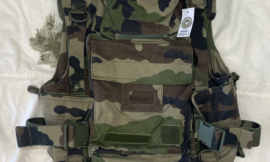The M1911, also known as the Colt 1911, is one of the most iconic and enduring handguns in history. Designed by John Browning and adopted by the United States military in 1911, this semi-automatic pistol has seen extensive use in various conflicts around the world and remains popular with military, law enforcement, and civilian shooters alike.
Historical Background
In the late 19th and early 20th centuries, the U.S. military was seeking a more effective sidearm to replace the .38 Long Colt revolvers, which had proven inadequate during the Philippine-American War. John Browning, a prolific firearm designer, developed the M1911, which was chambered in .45 ACP (Automatic Colt Pistol). The .45 ACP round was selected for its stopping power, addressing the need for a more potent cartridge.
After rigorous testing and competition with other designs, the M1911 was officially adopted by the U.S. military on March 29, 1911. It served as the standard-issue sidearm for the U.S. armed forces from its adoption through both World Wars, the Korean War, the Vietnam War, and various other conflicts, until it was formally replaced by the Beretta M9 in 1985.
Design and Features
The M1911 is renowned for its robust design, reliability, and stopping power. Key features include:
- Recoil Operation: The M1911 operates on a short-recoil principle, where the barrel and slide are temporarily locked together during the firing sequence. This design ensures reliable operation and efficient recoil management.
- Single-Action Trigger: The pistol is single-action only, meaning the hammer must be cocked manually or by cycling the slide before the first shot. This results in a consistent and crisp trigger pull.
- Manual Safety: The M1911 includes a thumb safety on the left side of the frame, which prevents the hammer from falling when engaged. This allows for “cocked and locked” carry, where the hammer is cocked, and the safety is on.
- Grip Safety: A secondary safety mechanism located on the back of the grip ensures the pistol cannot be fired unless it is gripped properly.
- Detachable Magazine: The M1911 uses a detachable single-stack magazine, typically holding seven or eight rounds of .45 ACP ammunition.
- Iron Sights: The standard M1911 is equipped with fixed iron sights, though many modern variants feature adjustable or enhanced sights for improved accuracy.
- Ergonomics: The pistol’s design includes an ergonomic grip angle and checkered grip panels, providing a comfortable and secure hold.
Variants
Numerous variants of the M1911 have been produced over the years to meet different operational requirements and preferences:
- M1911A1: Introduced in 1924, the M1911A1 featured several improvements over the original design, including a shorter trigger, an arched mainspring housing, and relief cuts behind the trigger to accommodate different hand sizes.
- Commercial Models: Colt and other manufacturers produced civilian versions of the M1911, which were popular for personal defense, competition shooting, and law enforcement use.
- Custom and Tactical Models: Modern variants often include enhancements such as extended safeties, beavertail grip safeties, improved sights, and accessory rails for mounting lights or lasers.
- Foreign Copies: Various countries have produced their own versions of the M1911, often with local modifications. Examples include the Argentine Ballester-Molina and the Norwegian Kongsberg Colt.
Military and Law Enforcement Use
The M1911 has seen extensive service with military and law enforcement agencies worldwide:
- U.S. Military: Used in both World Wars, the Korean War, the Vietnam War, and numerous other conflicts, the M1911 earned a reputation for reliability and effectiveness in combat. Even after being officially replaced by the M9, it continued to see use with certain special forces units.
- Allied Forces: Many allied countries adopted the M1911 during World War II, and it was widely used by various Commonwealth and European forces.
- Law Enforcement: The M1911 has been a popular choice for police and security forces, particularly in the United States, due to its stopping power and durability.
- Civilian Use: The M1911 remains a favorite among civilian shooters for self-defense, competition, and recreational shooting. Its customizable nature allows for extensive personalization to suit individual preferences.
Performance
The M1911 is known for its excellent performance characteristics:
- Reliability: The robust design of the M1911 ensures reliable operation under adverse conditions. Its simple and durable construction minimizes the risk of malfunctions.
- Accuracy: The single-action trigger and inherent design accuracy make the M1911 a precise shooting platform.
- Stopping Power: Chambered in .45 ACP, the M1911 delivers significant stopping power, making it highly effective in defensive situations.
- Ergonomics: The ergonomic grip design and balance contribute to ease of handling and shooting comfort.
Conclusion
The M1911 is more than just a firearm; it is a symbol of engineering excellence and a testament to John Browning’s genius. Its enduring popularity and continued use in various forms highlight its timeless design and effectiveness. Whether in military service, law enforcement, or civilian hands, the M1911 remains one of the most respected and revered handguns in history, embodying a legacy of reliability, power, and precision.


